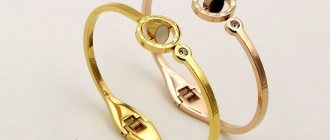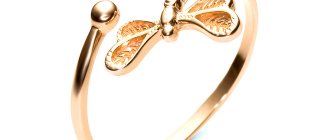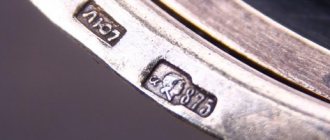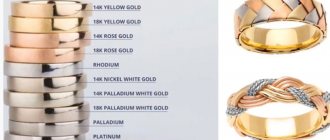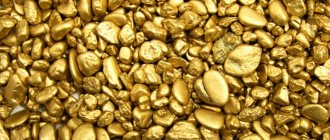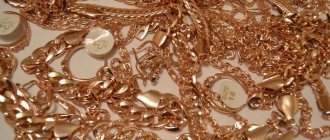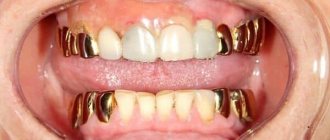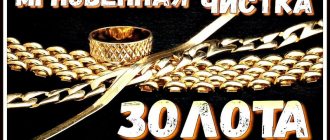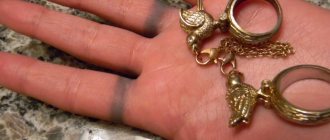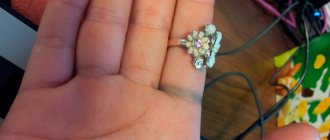Good afternoon, readers! In this article you will find information about one of the most complex processes in chemistry - the dissolution of gold. With the help of my tips, you can recreate the most severe reaction yourself and without special skills!
Gold is a fairly low-active metal. In nature, it is most often found as compounds. When an inexperienced chemist sets out to obtain pure precious metal, the question naturally arises in what gold dissolves. It is impossible to isolate it without dissolution. But finding a substance that will undergo a complex reaction is not an easy task; it’s not for nothing that gold is called a noble metal.
Industrial method
When extracting gold from so-called gold-bearing sands, you have to work with a suspension of approximately equally small particles of gold and grains of sand, which need to be separated from each other. You can do this by washing, or you can use sodium or potassium cyanide - there is no difference. The fact is that gold forms a soluble complex with cyanide ions, but sand does not dissolve and remains as is.
The key point in this reaction is the presence of oxygen (there is enough of it in the air): oxygen oxidizes gold in the presence of cyanide ions and a complex is obtained. If there is insufficient air or without cyanide, the reaction does not proceed.
Now this is the most common method of industrial gold production. Of course, there are still many stages before obtaining the final product, but we are specifically interested in this stage: cyanide solutions - what gold dissolves in.
Amalgam
The amalgamation process is also used in industry, only when working with ores and hard rocks. Its essence lies in the ability of mercury to form an amalgam - an intermetallic compound. Strictly speaking, mercury does not dissolve gold in this process: it remains in solid form in the amalgam.
During amalgamation, the rock is wetted with liquid mercury. However, the process of “pulling” gold into amalgam is long, dangerous (mercury vapor is poisonous) and ineffective, so this method is rarely used anywhere.
What other solvents exist?
How to dissolve gold without using hydrochloric and nitric acids? For this you will need another acid, hydrocyanic acid. This dissolution method can be achieved by cyanidation of ores. It is mainly used in industry because it is considered a technologically complex process that cannot be carried out at home.
How does the process work:
For a long time, cyanidation proceeded a little differently, today the process has been technically improved and has a different name - large leaching.
Used to extract gold from ore rocks in large enterprises. But the procedure has several disadvantages due to the fact that it is not possible to obtain gold from all ores in this way. It is necessary to take into account the properties of the metal.
If we are talking about sulfide ores, then in order to extract the noble metal from them, you will have to use complex technologies. It is necessary to subject the rock to special purification systems, which are called refining and are used in factories.
Gold also dissolves upon contact with mercury, but this is not exactly what is necessary. Amalgam is an alloy of mercury and gold. This method is interesting because in order to obtain the noble metal, the rock was mixed with mercury and additionally crushed in mills. Mercury formed an alloy with gold. The alloy was destroyed by washing, after which the mercury was removed and reused, since it did not lose its properties.
It is noteworthy that this method has been known to mankind since the 1st century AD, but it began to be used on a large scale only in the 16th century; this happened in Spain, whose territory at that time was an American colony. The reason for it all was a large deposit of mercury. Later the technology was improved. They began to use gateways with copper plates on which a thin layer of mercury was applied.
Source
Aqua regia
There are many acids that can corrode living tissue and leave terrible chemical burns (even death). However, there is no single acid in which gold dissolves. Of all the acids, only the famous mixture - aqua regia - can affect it. These are nitric and hydrochloric (hydrochloric) acids, taken in a ratio of 3 to 1 by volume. The remarkable properties of this hellish cocktail are due to the fact that acids are taken in very high concentrations, which greatly increases their oxidizing ability.
Aqua regia begins to act when nitric acid begins to oxidize hydrochloric acid first, and during this reaction, atomic chlorine is formed - a very reactive particle. It is she who attacks gold and forms a complex with it - chlorauric acid.
This is a very useful reagent. Very often, gold is stored in the laboratory in the form of crystalline hydrate of such an acid. For us, it only serves as confirmation that gold dissolves in aqua regia.
It is worth paying attention once again to the fact that it is not one of the two acids that oxidizes the metal in this reaction, but the product of their mutual reaction. So if you take, for example, “nitrogen” alone - a well-known oxidizing acid - nothing will come of it. Neither concentration nor temperature can make gold dissolve in nitric acid.
Section question - answer
How to make aqua regia to dissolve gold?
Expert opinion
Pribrezhny Gennady Valentinovich
Jeweler 6th category
The composition in which two acids act is obtained by combining them in a certain percentage ratio: 65-67% HNO3 and 33-35% HCl. When converted to pure substances, one to two.
How to precipitate gold from aqua regia at home?
Expert opinion
Grishanov Mikhail Petrovich
Jeweler, director of the Grishanov and Co. workshop
If you carry out the etching reaction at home, several chemical reagents are applicable and relatively safe:
- inkstone; FeSO4 is added with an aqueous solution, proportion 1 to 2;
- oxalic acid can be successfully used in secondary precipitation;
- sodium pyrosulfite is suitable for secondary precipitation, added in pure form, in an aqueous solution, requires caution: if something is done wrong, harmful gaseous substances will be released;
- Hydrogen peroxide must have a high concentration for the process to proceed.
- Hydrazine is a strong solvent, not very suitable for home use; if used, it must be added in small drops, since if not done carefully, an explosion may occur.
Mined gold after deposition
Bleaching
Unlike acids, particularly hydrochloric acid, individual substances can become what gold dissolves in. A widely known household bleach is a solution of chlorine gas in water. Of course, you can’t do anything with an ordinary store-bought solution; higher concentrations are needed.
Chlorine water acts as follows: chlorine dissociates into hydrochloric and hypochlorous acids. Hypochlorous acid decomposes under light into oxygen and hydrochloric acid. In such decomposition, atomic oxygen is released: like atomic chlorine in the reaction with aqua regia, it is very active and oxidizes gold for the sweet soul. As a result, a complex of gold and chlorine is again obtained, as in the previous method.
Step-by-step instructions for dissolving gold
Dissolving metal is a labor-intensive process. An effective way is to use zinc. It is used by chemists to isolate the purest metal of high purity.
There are many videos that clearly show a violent reaction with zinc.
Required materials and tools
The following tools are required:
- heating container;
- large tweezers;
- plate;
- fireproof flask;
- cap with a slot;
- apparatus for melting metals.
Materials:
- pure sodium tetraborate (borax);
- concentrated nitric acid;
- hydrochloric acid of medium concentration;
- zinc.
Dissolution process
A heating container made of fireproof glass or porcelain with a small depression in the center must be freed from moisture and heated on the stove. Add sodium tetraborate to the recess of the container. Place the gold scrap in a container and heat it. After making sure that the crowbar has turned red, sprinkle it with tetraborate.
The gold begins to melt, which means you need to add small pieces of zinc to it.
The resulting solution must be boiled. After cooling, add clean, cool water to the flask to wash out the precipitate. Shake the flask to settle the yellow flakes, carefully drain the water and rinse until the water in the flask is no longer cloudy.
Separate the sediment from the water using gauze, squeeze out excess water and sprinkle with sodium tetraborate. Tie the gauze into a tight knot, place it in the flask and heat until the gauze smolders and the tetraborate melts. A golden lump should form at the bottom of the flask.
As soon as the metal ingot hardens, it must be pulled out, cleaned of any remaining borax compounds with oxidized metals, by boiling for five minutes in a solution of nitric and hydrochloric acids. You should end up with a smooth and shiny gold bar.
Other halogens
In addition to chlorine, other elements of the seventh group of the periodic table also oxidize gold well. It is difficult to fully say about them: “that in which gold dissolves.”
Gold can react with fluorine in different ways: during direct synthesis (at a temperature of 300-400°C), gold fluoride III is formed, which immediately hydrolyzes in water. It is so unstable that it decomposes even when exposed to hydrofluoric acid, although it should be comfortable among fluoride ions.
Also, by the action of the strongest oxidizing agents: fluorides of noble gases (krypton, xenon), gold fluoride V can be obtained. Such fluoride generally explodes upon contact with water.
With bromine, things are somewhat simpler. Bromine is a liquid under normal conditions, and gold dissipates well in its solutions, forming soluble gold bromide III.
Gold also reacts with iodine when heated (up to 400°C), forming gold iodide I (this degree of oxidation is explained by the lower activity of iodine compared to other halogens).
Thus, gold certainly reacts with halogens, but whether gold dissolves in them is controversial.
Lugol's solution
In fact, iodine (common iodine I2) is insoluble in water. Let’s dissolve its complex with potassium iodide. This compound is called Lugol's solution - and it can dissolve gold. By the way, it is often used to lubricate the throat of those with a sore throat, so not everything is so simple.
This reaction also occurs through the formation of complexes. Gold forms complex anions with iodine. It is used, as a rule, for etching gold - a process in which interaction occurs only with the surface of the metal. Lugol's solution is convenient in this case because, unlike aqua regia and cyanide, the reaction is noticeably slower (and the reagents are more accessible).
The most powerful cleaning products, or How to avoid a trip to the workshop
There is an even more sophisticated way to clean gold from iodine without resorting to the help of professionals, whose services are expensive and the results are unpredictable. We are preparing a real “hellish mixture”!
Don't be afraid of its ingredients; they are all individually quite harmless, at least for metals. You need to take regular soda - 2-3 tablespoons, 50-70 g of quicklime, a couple of tablespoons of sodium chloride (ordinary table salt) and one spoon of 9% vinegar.
Dissolve all components in hot water and bring to a boil. Then turn off the stove and lower our gold or silver into the hot mixture. We take it out and carefully examine our jewelry, repeating the process until it is completely restored.
Bonus
When we said that single acids are something in which gold does not dissolve, we lied a little - in fact, such acids exist.
Perchloric acid is one of the strongest acids. Its oxidizing properties are extremely high. In a dilute solution they show up poorly, but in high concentrations they work wonders. The reaction produces its salt, gold perchlorate, which is yellow and unstable.
Of the acids in which gold dissolves, there is also hot concentrated selenic acid. As a result, a salt is also formed - gold selenate of red-yellow color.
How to dissolve gold jewelry step by step?
First of all, if the material is scrap precious metal or a product with impurities, cleaning should be carried out using ferromagnetic intervention.
The process then continues in the form of treatment with pure nitric or other acids. Only after this can you begin direct dissolution.
You should start with accurate measurements of proportions. That is, if the mass of the potential material is 1 gram, you should prepare 3.75 milliliters of concentrated hydrochloric acid, then mix everything in a container.
Almost immediately after mixing, dissolving processes should occur. As soon as the reaction is complete, the solution is drained and repeated as in the first case.
After adding 2 portions of hydrochloric acid, the flask must be heated. During the heating process, the next component in the form of nitric acid is slowly introduced.
Within a short time, the precious metal will completely dissolve, but it should be noted that the definition of completely means exclusively the gold component. Other components, for example, silver, tend to be passivated.
Once the entire process has reached the completion stage, you should wait 20-30 minutes, maintaining the heating temperature at the same level.
Under no circumstances should the heating process be allowed to boil. If this happens, the precious metal will begin to precipitate ahead of time, and this will significantly complicate the further stage of deposition of the aurum in its pure form.
Source
